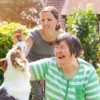Cognitive behavioral therapy (CBT) is a structured, short-term, goal-oriented form of talk therapy. Positive Psychology further explains CBT as a “psycho-social intervention that focuses on changing unhelpful thoughts, beliefs, attitudes and behaviors, improve emotional regulation and create a suite of coping strategies to solve problematic issues.”
The CBT model fundamentally believes that the meanings assigned to incidences are what drive the associated upsetting emotions, not the events themselves.
During CBT sessions, a young person will have the opportunity to test out their automatic thoughts and see if they are accurate or if they are simply a direct manifestation of an inaccurate, dysfunctional assumption. Through CBT a child can learn to replace these erroneous assumptions and adjust negative self-views by way of behavior modification, which is typically reinforced through exposure therapy.
What Is Exposure Therapy?
Exposure therapy is a highly effective, evidence-based treatment technique for children and adolescents with anxiety disorders. It is also an essential component of CBT treatments for other adolescent mental health conditions such as phobias, panic disorder, post-traumatic stress disorder (PTSD), obsessive-compulsive disorder (OCD), social anxiety disorder, and more. Exposure therapy aims to reduce a young person’s fear and anxiety responses. The American Psychological Association (APA) indicate that there are several variations of exposure therapy, some of which are highlighted below:
- In vivo exposure: directly facing a feared object, situation, or activity in real life (e.g., a child with social anxiety might be instructed to give a speech in front of an audience).
- Imaginal exposure: vividly imagining the feared object, situation, or activity (e.g., an adolescent with PTSD might be asked to recall and describe his or her traumatic experience to reduce feelings of fear).
- Interoceptive exposure: deliberately and strategically inducing the somatic symptoms associated with a threat appraisal and encouraging the adolescent to maintain contact with the feared sensations.
The APA further explains that exposure therapy in CBT for adolescents can be paced in different ways:
- Graded exposure: the psychologist helps the child construct an exposure fear hierarchy, which entails ranking feared objects, activities, or situations according to difficulty. They begin with mildly or moderately difficult exposures, then progress to more difficult ones.
- Flooding: using the exposure fear hierarchy to begin exposure with the most difficult tasks.
- Systematic desensitization: combining exposure with relaxation exercises to make them feel more manageable and to associate the feared objects, activities, or situations with relaxation.
Research has shown the more exposure is disseminated is directly linked to treatment outcome and improved mental health.
Further Information and Support
For most of us, life can be very stressful, leading us to feel emotionally charged, which can cause anxiety, panic attacks, depression, and getting stuck in a cycle of being burdened with negative thoughts. Navigating through the challenges and emotional turmoil of life can be overwhelming, but you do not have to go through it alone. Engage Treatment is a Joint Commission Accredited professional psychological practice. We specialize in treating children, teens, and young adults struggling with depression and anxiety through community-focused treatment plans that incorporate a carefully selected combination of therapeutic interventions. Our compassionate, multidisciplinary practitioners are devoted to providing the highest quality of care that helps ignite positive change and enables clients to reach optimal health and well-being. Please do not hesitate to reach out for guidance. We are happy to answer questions and provide you with any additional information. Feel free to call us at 805-497-0605 or email us at [email protected]. You are also welcomed to get in touch by filling out our contact form. We look forward to connecting and having the opportunity to discuss how we might best be able to support you.
Contact Us
Westlake Campus:
IOP Program
2625 Townsgate Road, Suite 210
Westlake Village, California 91361
Agoura Campus:
Private Therapy & Parenting Program
30300 Agoura Road, Suite 250
Agoura Hills, CA 91301
805-497-0605
805-371-4862











© 2023 Engage Treatment Program, Inc. All Rights Reserved.
LGBTQ Friendly
About
• About Engage
• Our Team
• Career Opportunities
• Individual / Family Therapy






